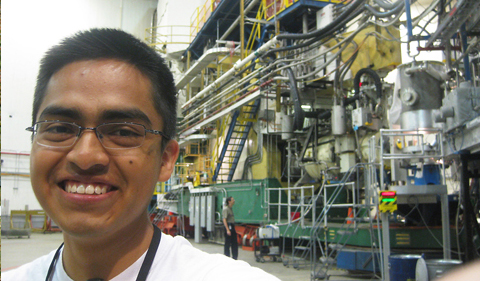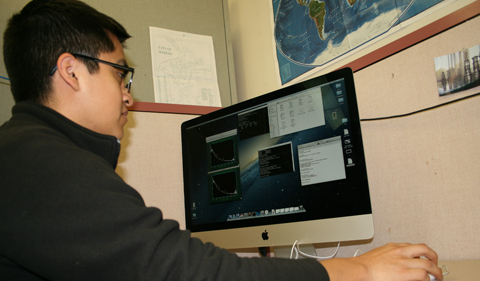By Miguel Gomez
B.S. Physics and Mathematics, Class of 2015
For two months this summer, I had the opportunity to work with Dr. Paul King, Research Assistant Professor of Physics at Ohio University, at the Thomas Jefferson National Accelerator Facility (JLab) in Newport News, VA.
Dr. King, a research assistant professor in the Department of Physics & Astronomy, is working on simulations for a new experimental proposal to measure the contributions of the pion cloud to the structure function of the nucleon. Dr. King introduced me to research and staff scientists who are conducting theoretical and experimental projects ranging from superconducting radio-frequency (SRF) technologies to medical imaging devices.
While at JLab, I learned that protons and neutrons can fluctuate into virtual baryon-meson states, developing a “cloud” of pions surrounding the nucleon. In some high-energy electron scattering events, the electron should scatter from the quarks in the virtual pion, leaving a “low-energy” recoil nucleon from the virtual baryon-meson state. By measuring the recoil nucleon, researchers can “tag” the electron scattering as coming from the virtual pion. The objectives are to measure over a wide range in the energy of the recoil proton to extract both the fragmentation function, describing the likelihood of finding the virtual baryon-meson state, and the pion structure function, describing the distribution of quarks in the virtual pion.
Working from an earlier calculation, I developed a C++ simulation of this process that will help refine the design of the experiment. In addition to my work on the simulation, I participated in the installation of the DVCS (Deep Virtual Compton Scattering) experiment in Hall A, which will be the first experiment to be performed at Jefferson Laboratory after the much anticipated 12-GeV upgrade.
I met with Dr. King on a daily basis, which proved helpful because he would provide answers to my questions. I would also meet with Dr. Julie Roche, Associate Professor of Physics at Ohio University, and her graduate student Mongi Dlamini, once a week and discuss current and future projects.
Living in Newport News was fun and exhilarating. There were many museums, theme parks, and international restaurants nearby the city. One main attraction in the area is Virginia Beach, where the oscillating waves and clear skies provided the perfect way to relax.
The best thing about my summer internship was that I gained more programming experience in the field of particle physics. Learning about various programming languages (such as ROOT, Fortran, etc.) has helped me understand the kinematics of subatomic particles and their applications in nature.
Miguel Gomez – Intern with Dr. Paul King – senior at Ohio University – College of Arts & Sciences – astrophysics major




















Comments